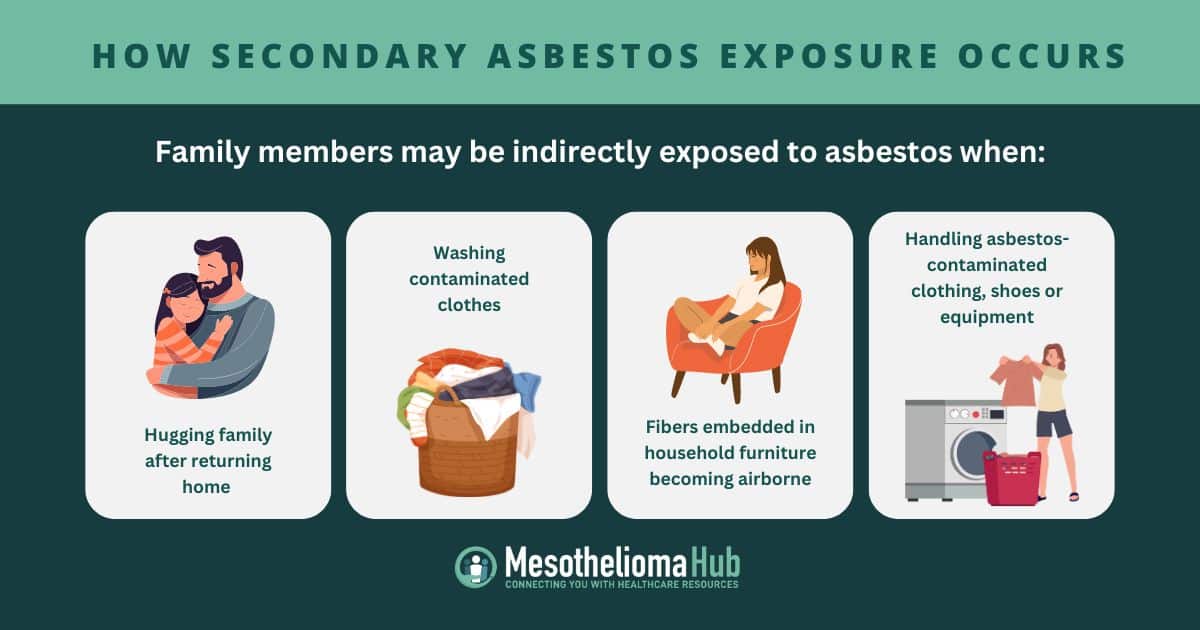Medically Reviewed by: Muaiad Kittaneh, MD, FACP, MBA | January 28th, 2020
A person can be exposed to asbestos in several ways. Not only can it affect employees who work near asbestos directly, but it can also indirectly impact the people around them, such as family members or close friends. This is known as indirect or secondary exposure. Keep reading to learn what to do if you were indirectly or secondarily exposed.

When asbestos fibers are disturbed, they are released into the air and tend to cling to the clothing, skin, or hair of those who work with or around it. These microscopic fibers are often tracked into the home and end up embedded in your furniture and carpet. Since asbestos fibers can be tracked home on workers’ clothes, their loved ones are also at risk of exposure through secondary asbestos exposure.
Fibers that are knocked loose become airborne, exposing everyone in the household to the toxic fibers. Prolonged exposure to the mineral has been known to cause respiratory diseases, including mesothelioma and asbestosis. We understand how scary it can be to have a loved one work in an occupation with a high asbestos exposure risk. Read to learn more about secondary asbestos exposure, who is most at risk, how to recognize symptoms, and how to protect your family.
Secondary asbestos exposure occurs when people who haven’t directly worked with asbestos breathe in fibers unknowingly. The real danger comes from these fibers lingering in the home environment for years. Even minor disturbances can cause them to become airborne, posing a risk to family members.
Symptoms of secondary asbestos exposure may take longer to develop compared to direct exposure, but they can still be severe and potentially fatal. Consistent exposure to asbestos fibers can lead to serious diseases such as mesothelioma and asbestosis, commonly associated with asbestos exposure. Health problems often appear decades after the initial exposure, making early detection and diagnosis crucial. If you’re concerned about potential asbestos exposure, consult a doctor to discuss your risk factors and any symptoms you might be experiencing. Here are the most common symptoms associated with asbestos exposure; if you experience any of them, it’s important to see a doctor to determine the cause.
Families of individuals who come into contact with asbestos are at the highest risk of secondary exposure. Workers unknowingly expose their family and friends to this known carcinogen, putting them at risk of developing serious illnesses such as mesothelioma or asbestosis. Due to the long latency period of 10 to 50 years, those who develop mesothelioma often aren’t diagnosed until later in life, making it difficult to pinpoint the exact source of asbestos exposure. Although mesothelioma, the disease associated with asbestos exposure, is more common in men, women are also vulnerable to the disease if exposed enough over time.
Another group facing a high risk of secondary asbestos exposure includes those who frequently encounter asbestos workers such as family members and friends. This group typically includes significant others, children, coworkers, friends, or roommates. Specific case studies have shown that individuals who developed mesothelioma from indirect asbestos exposure often worked in administrative roles in factories or construction sites where asbestos was present.
Asbestos fibers were once used heavily in occupational industrial capacities, affecting thousands of workers and their families. Equipment and materials containing asbestos were commercially used for many purposes because of its strength and heat resistance properties. Even today, asbestos can still be found in older homes and workplaces, lurking inside their walls, roofs, gutters, pipes, insulation, and floor tiles.
Asbestos and products containing the mineral were commercially used for many different purposes due to their heat resistance properties. To this day, asbestos materials are still found in homes and workplaces, as it was widely used in wall and roofing sheets, gutters, pipes, insulation, and ceiling and floor tiles. Some of the occupations at risk for asbestos exposure include, but are not limited to, construction workers, firefighters, first responders, miners, factory workers, railroad workers, and teachers.

If you’re the owner, contractor, or manager of an asbestos structure, even if you only have a suspicion of the fact, it’s your responsibility to take immediate action and measures toward adequate asbestos removal. It’s illegal to expose employees and residents, even accidentally, and you can be fined a lot for corporate negligence. Not to mention, lives are at risk. Even if the responsible party didn’t know of the presence of the mineral, they can still be held liable.
Asbestos fibers are incredibly persistent and can linger in your home for years. Even minor asbestos exposure disturbances, such as bumping into furniture or fabrics containing asbestos, can release these fibers into the air, putting unsuspecting family members at risk of repeated exposure. Studies have shown that secondary exposure to asbestos, often through family members of asbestos workers, significantly increases the risk of developing diseases like mesothelioma.
It’s illegal to expose employees and residents, even unknowingly, and corporations that fail to remove asbestos properly are fined for negligence. If you’re an owner, contractor, or manager and suspect your structure contains asbestos, it’s your responsibility to follow all regulations sent into place for asbestos abatement. The NESHAP is the most recent and updated set of rules under the Clean Air Act developed by the EPA. The act aimed to minimize the amount of asbestos released into the air during the removal process. All structures containing asbestos must have the toxic fibers adequately removed by professionals before demolition or renovation.
Non-occupational asbestos exposure occurs when individuals come into contact with asbestos outside their work environments. This type of exposure often affects family members and friends of workers handling asbestos. When asbestos fibers are disturbed, they become airborne and cling to clothing, skin, or hair. These microscopic fibers are then carried into homes, embedding themselves in furniture, carpets, and other surfaces. Minor disturbances, like bumping into furniture or doing laundry, can release these fibers back into the air, repeatedly exposing household members and leading to serious respiratory diseases, including mesothelioma and asbestosis. Families of asbestos workers are at the highest risk of secondary exposure, as the fibers can easily be brought home. Even activities such as hugging a worker or washing their clothes can result in exposure.
Yes, you deserve compensation even if you weren’t directly exposed. If your loved one has worked in a known asbestos structure, or you suspect they may have been exposed, you may be entitled to legal compensation for being wrongfully exposed and to help pay your medical expenses. Complete our free case evaluation form or contact one of our patient advocates for help navigating the legal process.
Jennifer Verta thrives as a digital content writer at Mesothelioma Hub. She has been producing content for clients since before she graduated from the University of Colorado at Denver with a Bachelor of Arts in Communication and a Minor in English Writing. Jen’s mission is to help promote awareness of mesothelioma to as many people as possible by providing only the most up-to-date and accurate content available. When she isn’t cranking the gears at work, Jen can be found snowboarding, hiking, catching live music, or socializing with friends.

Dr. Muaiad Kittaneh, MD, FACP, MBA, is a medical oncologist and assistant professor at Loyola University of Chicago. His journey in healthcare includes Internal Medicine training at Advocate Christ Medical Center/University of Illinois of Chicago, where he excelled as Chief Resident. Dr. Kittaneh further honed his expertise at the University of Miami.
Dr. Kittaneh has conducted extensive research and assisted in many clinical trials. His notable contributions have been published in journals across the United States, which focus particularly on breast, melanoma, and gastrointestinal cancers. As an expert medical reviewer, Dr. Kittaneh plays a crucial role in shaping and evaluating Mesothelioma Hub’s content, ensuring accuracy and relevance in the field.
CancerCare. (2018). Maintaining good Mental Health When Coping With a Cancer Diagnosis. Retrieved on July 3rd, 2019 from https://cancercare.org/blog/maintaining-good-mental-health-when-coping-with-a-cancer-diagnosis
CancerCare. (2016). How to Recognize and Change Negative Thought Patterns When You Have Cancer. Retrieved on July 3rd, 2019 from https://cancercare.org/publications/312-how_to_recognize_and_change_negative_thought_patterns_when_you_have_cancer
Harvard T.H. Chan, School of Public Health. (2019). Healthy Eating Plate. Retrieved on July 2nd, 2019, from https://hsph.harvard.edu/nutritionsource/healthy-eating-plate/
Oncology Nursing Society. General. (2011). General Exercise Guidelines for Cancer Survivors. Retrieved on July 2nd, 2019 from https://ons.org/sites/default/files/Cancer_patient_general_exercise_brochure.pdf
US National Library of Medicine, National Institutes of Health. (2001). Cognitive behavioral therapy for cancer-related cognitive dysfunction. Retrieved on July 2nd, 2019 from https://ncbi.nlm.nih.gov/pmc/articles/PMC5285475/
US National Library of Medicine, National Institutes of Health. (2017). Environmental Asbestos Exposure and Risk of Mesothelioma. Retrieved on July 2nd, 2019, from https://ncbi.nlm.nih.gov/pmc/articles/PMC5497111/
US National Library of Medicine, National Institutes of Health. (2018). The Significance of Non-Occupational Asbestos Exposure in Women with Mesothelioma. Retrieved on May 17th, 2019, from https://ncbi.nlm.nih.gov/pmc/articles/PMC6246071/